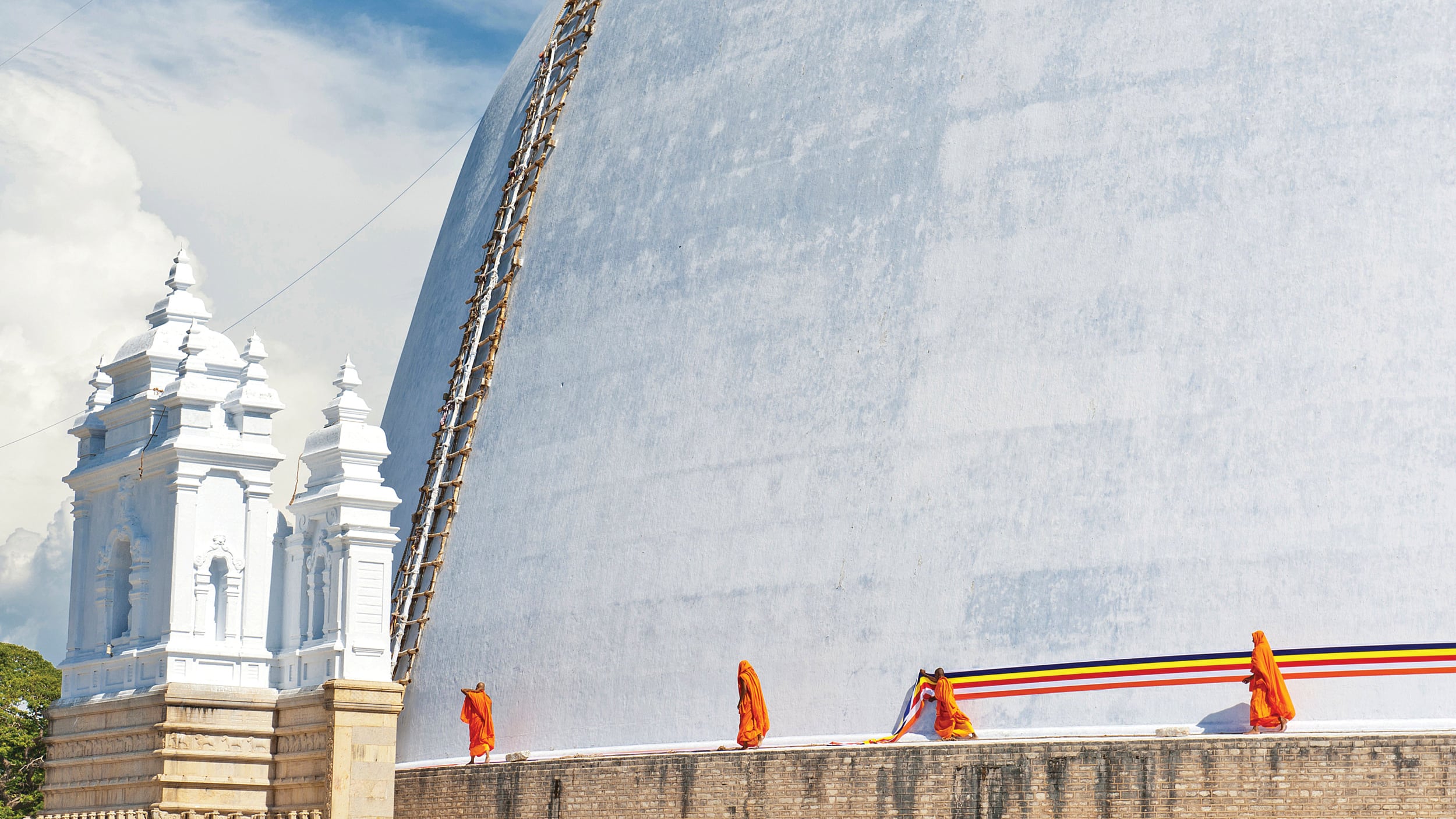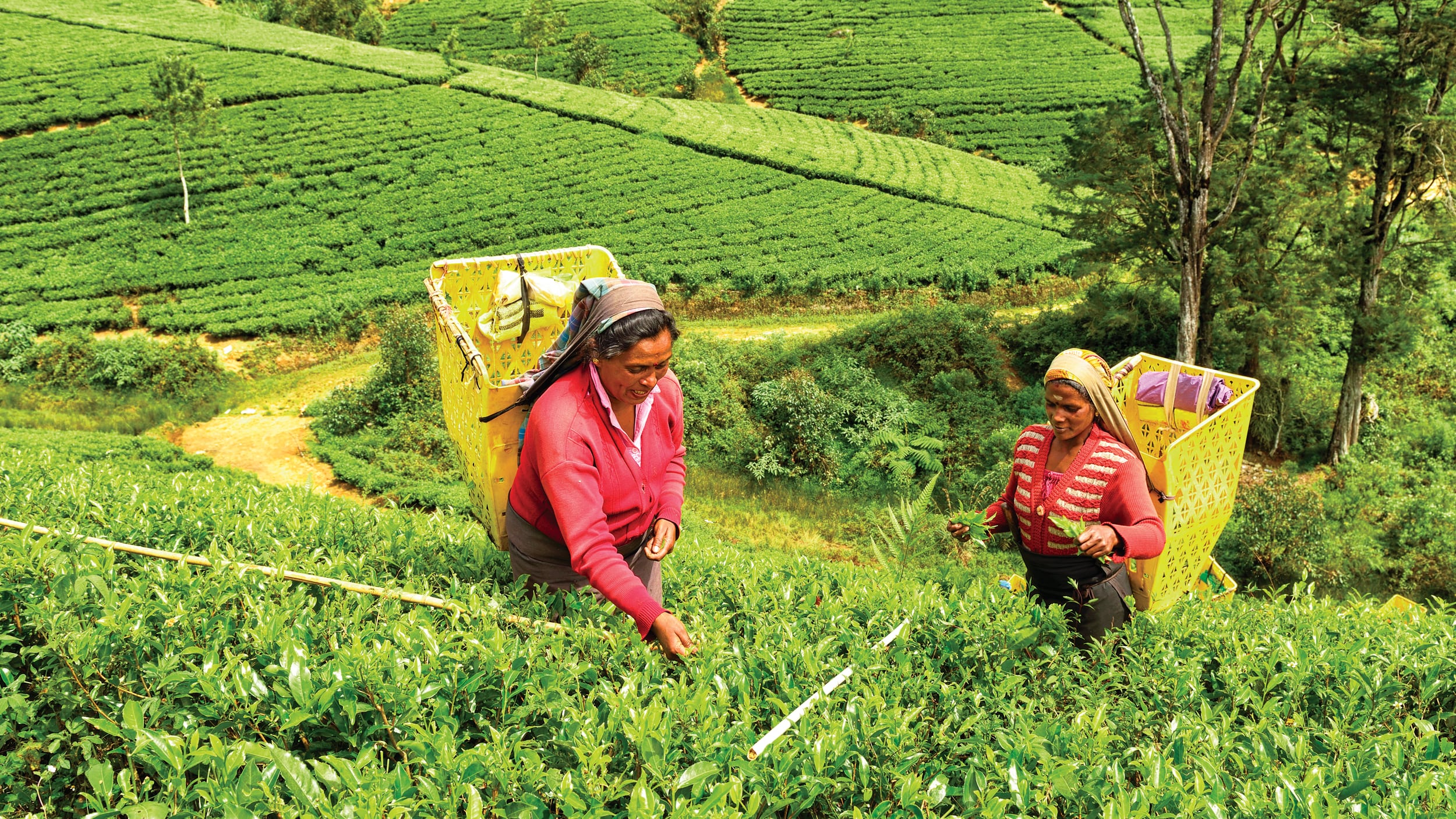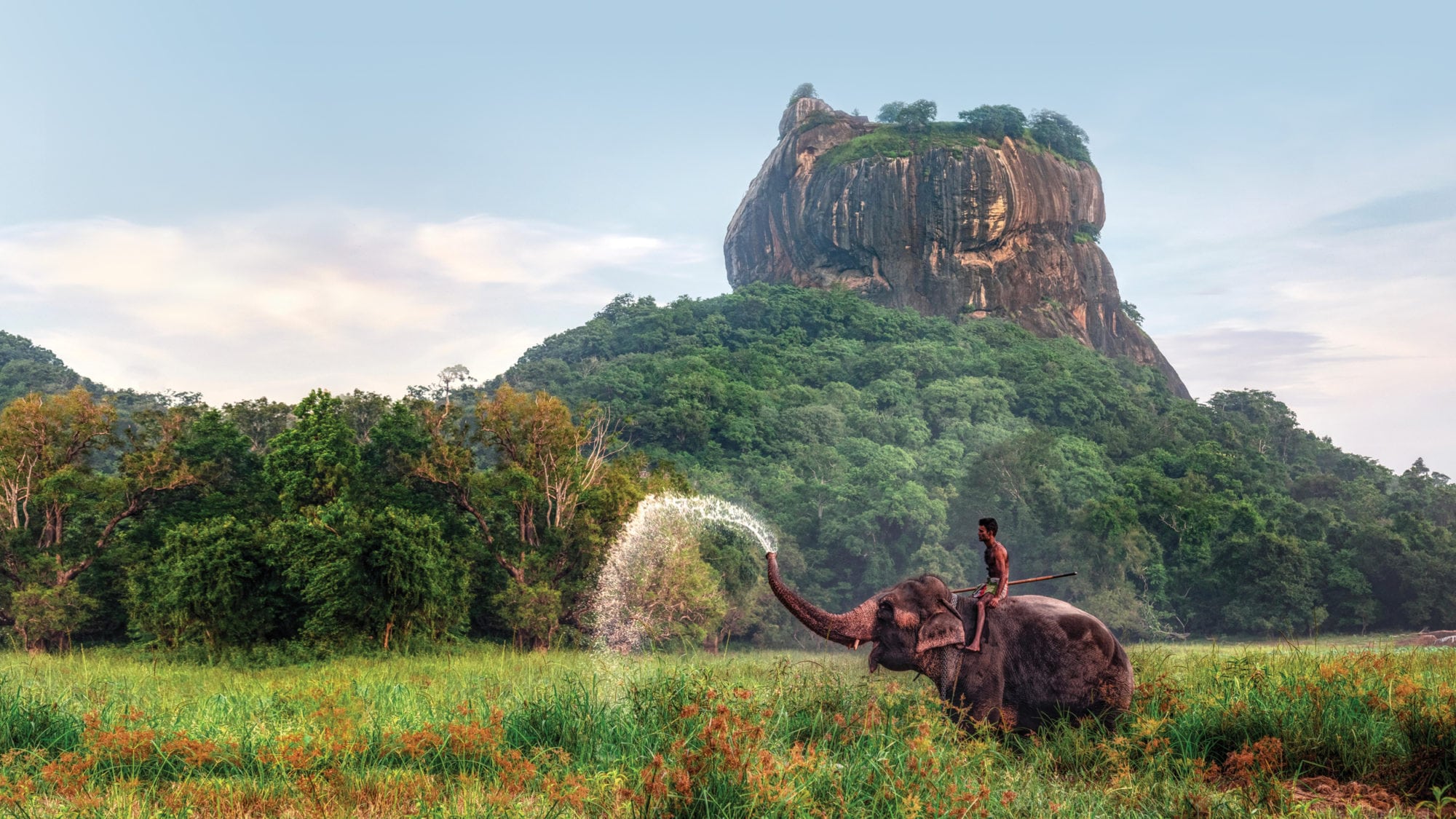After hours on the road, I find myself somewhere in northwest Sri Lanka. I’m exhausted, but the lush vegetation bordering the highway soothes my bleary eyes. Road signs feature the curvy characters of Tamil and Sinhalese; bursts of fluorescent light illuminate curbside vendors and soon I’m welcomed into a local hotel with cool drinks, the scent of fresh flowers and a quiet room to rejuvenate before my explorations begin.
Sitting near the southern tip of India, Sri Lanka’s original capital, Anuradhapura, was founded in the fourth century BC. It was part of the Silk Road, the legendary trade route that connected South and Central Asia with the Middle East and Europe. Known as Ceylon under British colonial rule, Sri Lanka severed ties with Britain in 1972 but quickly spiralled into a 26-year civil war. The conflict ended in 2009, and since then tourism has taken off, with travellers curious to discover the ancient culture of this South Asian country.
My tour, National Geographic Journeys’ Discover Sri Lanka with G Adventures, begins with a quick Sinhalese language lesson. G Adventures CEO (chief experience officer) Sam Jayathilaka teaches our group to say ayubowan, which translates to “may you live long” and is used as an all-purpose salutation: hello, welcome or goodbye.
Sam encourages me to sample a Sri Lankan breakfast staple: mee kiri, buffalo milk curd with palm treacle, a sweet syrup made from the Palmyra palm tree. As I dig in on the open-air patio, I spot a toque macaque hungrily eyeing our morning meal. The species of brown-and-white monkey is ubiquitous in the region; I see them daily.
Anuradhapura, a UNESCO World Heritage Site, kicks off our history lesson. The 40-square-kilometre stretch is one of the world’s longest-inhabited cities and has been a sacred place for Buddhists throughout the centuries. It’s an area dotted with majestic domed shrines known as stupas, which house Buddhist relics.
After seeing the truly immense Ruwanwelisaya stupa, surrounded by elephant statues and napping monkeys, we continue on to Mirisawetiya Vihara stupa. I walk barefoot with the faithful, who leave offerings of fragrant lotus and marigold. The stark white structure pops with colourful fabric wrapped around its base—the navy, red, white, orange and yellow of the Buddhist flag. Families gather and fill the air with gentle murmurs of prayers.
Nearby, ancient ruins become an impromptu cricket pitch for some local boys. Before leaving the dusty site, we visit smaller stupas and the Samadhi statue, a two-metre granite Buddha, one of the oldest of its kind here.

A couple of hours outside of lovely Anuradhapura, we transfer to safari vehicles to enter Kaudulla National Park. We bounce along the muddy road, passing strutting peacocks, until we arrive at the Kaudulla Tank, a man-made lake originally constructed in the third century AD by King Mahasena. The freshwater lake attracts all manner of thirsty creatures at the height of the dry season, including the country’s population of migratory elephants.
Twenty pachyderms drink at the water’s edge when we arrive; water buffalo and egrets soon join in. Baby elephants hide between their taller moms as bulls circle at a distance, hopeful for an interlude with a willing female. We move along before any intimate encounters commence.
At Dambulla Caves Temple, a monastery complex and sacred site, monkeys make for unlikely sentries along the steep and winding staircases. Created over centuries, the five caves feature walls lined with colourful paintings of Buddha, as well as 150 sculptures of the deity, Sri Lankan kings and other gods and goddesses. We have a similar ancient-art experience later that day at Sigiriya, a rock fortress and terraced garden that was built in AD 480 as the country’s new capital. Centuries-old frescoes are still visible as we climb the steep 1,200 steps to the top.
MORE TO READ
Off the tourist track in Bangkok, Thailand
In Kandy in central Sri Lanka, our hotel clerk cautions against leaving balcony doors open on account of the pesky monkeys. Heeding his advice, we lock them tight before departing for the holy Sri Dalada Maligawa, the Temple of the Sacred Tooth. Within this former royal palace, I squeeze through the crowds to get a glimpse of the prized relic: a piece of Buddha’s tooth. Legend has it that the tooth gives the owner the divine right to rule. After a quick peek, I seek out an ayurvedic massage, a reward for all my stair climbing.
Suitably relaxed, I make my way to the Sthree Craft Shop and Café for my first taste of Sri Lankan afternoon tea. Established by the Women’s Development Centre, the cozy shop features traditional crafts made by female entrepreneurs, plus a newly opened café offering Sri Lankan-style afternoon tea with coconut treats.
It’s the perfect segue to our next stop: Sri Lanka’s tea country. Verdant tea bushes line the hills as we drive the winding road to Nuwara Eliya, the centre of the country’s tea industry. During a tour of the Bluefield Tea Gardens, I note that all of the field workers are women. Our guide explains that they tend to have a more delicate touch for handpicking leaves. Each worker averages an impressive 20 kilograms a day.
At the end of the tour, a steaming cup of OPA Ceylon orange pekoe awaits. As I sip the fragrant liquid and look out over leafy fields, I can’t help but wonder if I’m drinking the perfect cup of tea in the most perfect setting.
If nothing else, it’s certainly a contrast to the ritualistic British high tea we later indulge in at the Grand Hotel, our home for the night. White-gloved servers pour from steaming teapots into delicate china cups, while we nibble on an array of finger sandwiches, dainty cakes, warm scones and jars of clotted cream.

After a crowded train ride through the mountains to Bandarawela, our group heads a few hours south to Udawalawe National Park. At Eco Camp, it’s time to try my hand at Sri Lankan glamping. My spacious safari-chic tent is the perfect spot to freshen up after a dusty trek. A short time later, camp chef Darshana Nuwan teaches us how to make two Sri Lankan specialties: parippu (lentil) curry and pol sambol (a spicy coconut condiment), before we dine under the stars.
When it comes to wildlife, the Udawalawe region is second to none. Guides take us into the national park, where we spot water buffalo cooling off in a muddy watering hotel and a Sri Lankan elephant mother doting on her calf. Unlike other parts of the world, Udawalawe’s elephant population is growing. I’m lucky to see a large male swimming contentedly, then submerging his entire bulk beneath the water’s surface—all except for the tip of his trunk.
The park boasts many other fascinating creatures as well: A caiman carefully reveals itself at the shoreline, golden jackals pop out of the brush, wee Macquarie monkeys cheerfully frolic and land monitor lizards slowly move across trails.
MORE TO READ
Kenya’s Maasai Mara: Legendary landscapes and iconic culture
After full days exploring Buddhist sites and natural wonders on foot, I’m glad to explore the park via safari Jeep. Watching animals frolic in watering holes has me wishing for a swim myself. When I make my inevitable return to Sri Lanka, I’ll be sure to build in a few days for seaside lounging. The ancient region of Galle, on the southwest coast of the island, boasts several stunning beaches, including Hikkaduwa or Dikwell, perfect for swimming and more adrenaline-pumping pursuits like kite- or wind surfing.
 My last view of Udawalawe is that of a young female elephant. Her calm, gentle nature—and curiosity to see around the next tree—feel similar to my own journey through her island home. My restful state seems fitting in this place, which the Romans called Serendivis. The serene-sounding names seems fitting for an island full of warm people, beautiful beaches and laid-back experiences.
My last view of Udawalawe is that of a young female elephant. Her calm, gentle nature—and curiosity to see around the next tree—feel similar to my own journey through her island home. My restful state seems fitting in this place, which the Romans called Serendivis. The serene-sounding names seems fitting for an island full of warm people, beautiful beaches and laid-back experiences.
SEE IT WITH AMA
Discover Sri Lanka (National Geographic Journeys by G Adventures): A 12-day small-group tour (max. 15 guests) from Colombo to Negombo. You’ll explore ancient sites and religious landmarks, while participating in hands-on experiences.
From $2,599 (tour only)
Sept. 2018 to Dec. 2019 departures
Go Solo Southern India & Sri Lanka (AMA Travel): A 19-day adventure guided by AMA product specialist Elaine Le Jambe. See spice plantations, overnight in a houseboat, wander through temples and relax on beautiful beaches. Includes return airfare from Edmonton or Calgary, domestic flights, 17 nights’ accommodations, sightseeing, gratuities, some meals and more.
From $9,308 (share a room to save $1,200)
Feb. 4–23, 2019
Call a Travel Specialist: 1-866-667-4777
AMATravel.ca/Groups
